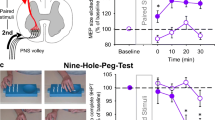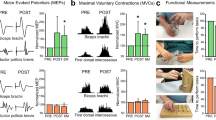Abstract
In experimental animals, it has been demonstrated that a corticospinal direct (D) response to stimulation of the motor cortex can be recorded from the lateral column of the spinal cord or the spinal epidural space (7, 9, 15). Recently, it has been reported that identical responses can be recorded in humans with transcranial brain stimulation (1, 10, 11). Such a technique would be of great clinical value for monitoring pyramidal tract (PT) functions during intracranial and intraspinal surgery. However, it may not be certain whether spinal cord responses to transcranial brain stimulation really represent impulses mediated by PT neurons since, to the best of our knowledge, no detailed data regarding corticospinal D response to stimulation of the exposed motor cortex of humans is currently available for comparison (10). We have previously compared corticospinal D response to stimulation of exposed motor cortex and spinal cord responses to transcranial brain stimulation in the cat, and we have found that spinal cord responses to transcranial brain stimulation are easily confused with responses other than corticospinal D response (7). However, because of the tremendous difference in brain volume between the cat and humans, any conclusion must await studies in humans. In our neurosurgery department, we have five years’ experience recording corticospinal D response to stimulation of the motor cortex while exposed for intracranial surgery. We made these recordings for the purpose of identifying the motor cortex and protecting it from surgical damage. The data obtained appears to provide useful information for comparison of corticospinal D response and spinal cord responses to transcranial brain stimulation in humans. We, therefore, summarize herein our experience of recordings of human corticospinal D response during intracranial surgery.
Access this chapter
Tax calculation will be finalised at checkout
Purchases are for personal use only
Preview
Unable to display preview. Download preview PDF.
Similar content being viewed by others
References
Boyd, S.G.; Rothwell, J.C.; Cowan, J.M.A.; Webb, P.J.; Morley, T.; Asselman, P.; Marsden, C.D.: Amethod of monitoring function in corticospinal pathways during scoliosis surgery with a note on motor conduction velocities. J. Neurol. Neurosurg. Psychiat. 49: 251–257, 1986.
Brookhart, J.M.; Morris, R.E.: Antidromic potential recordings from the bulbar pyramid of the cat.J. Neurosurg. 11: 387–398, 1948.
Chang, H.T.: Dendritic potential of cortical neurons produced by direct electrical stimulation of thecerebral cortex. J. Neurophysiol. 14: 1–21, 1951.
Deschenes, L; Labelle, A.; Landry, P.: Morphological characteristics of slow and fast pyramidal tractcells in the cat. Brain Res. 178: 251–274, 1979.
Hassan, N.F.; Rossini, P.M.; Cracco, R.Q.; Cracco, J.B.: Unexposed motor cortex activation by lowvoltage stimuli. In: C. Morocutti; P.A. Rizzo (eds.): Evoked Potentials: Neurophysiological And Clinical Aspects. Amsterdam, Elsevier, pp. 107–113, 1985.
Hern, J.E.C.; Landgren, S.; Phillips, C.G.; Porter, R.: Selective excitation of corticofugal neurones bysurface stimulation of the baboon’s motor cortex. J. Physiol. (Lond.), 161: 73–99, 1962.
Katayama, Y.; Tsubokawa, T.; Sugitani, M.; Maejima, S.; Hirayama, T.; Yamamoto, T.: Assessmentof spinal cord injury with multimodally evoked spinal cord potentials. Part1. Localization of lesions in experimental spinal cord injury. Neuro-Orthopedic 1: 130–141, 1986.
Lance, J.W.: Pyramidal tract in spinal cord of cat. J. Neurosphysiol. 17: 253–270, 1954.
Landau, W.M.; Bishop, G.H.; Clare, M.H.: Site of excitation in stimulation of the motor cortex. J. Neurophysiol. 29: 1206–1222, 1966.
Levy, W.J., Jr.; York, D.H.: Motor tract evoked potentials. In: R.H. Nodar; C. Barber (eds.): Evoked Potentials II. Butterworth, Boston, pp. 363–372, 1984.
Levy, W.J.; York, D.H.; McCaffrey, M.; Tannzer, F.: Motor evoked potentials from transcranial stimulation of the motor cortex in humans. Neurosurg. 15: 287–301, 1984.
Lloyd, D.P.C.: The spinal mechanism of the pyramidal system in cats. J. Neurophysiol. 4: 525–546, 1941.
Marsden, C.D.; Merton, P.A.; Morton, H.B.: Percutaneous stimulation of spinal cord and brain: Pyramidal tract conduction velocities in man. J. Physiol. 328: 61, 1982.
Merton, P.A.; Morton H.B.: Stimulation of the cerebral cortex in the intact human subject. Nature 285: 227, 1980.
Patton, H.D.; Amassian, V.E.: Single and multiple unit analysis of cortical stage of pyramidal tract activation. J. Neurophysiol. 17: 345–363, 1954.
Philips, C.G.; Porter, R.: Corticospinal Neurons. London: Academic press, p. 268, 1977.
Purpura, D.P.; McMurty, J.G.: Intracellular activities and evoked potential changes during polarization of motor cortex. J. Neurophysiol. 28: 166–185, 1965.
Rank, J.B., Jr.: Which elements are excited in electrical stimulation of mammalian central nervous system. A review. Brain Res. 98: 417–440, 1975.
Rossini, P.M.; Marciani, M.G.; Caramia, M.; Hassan, N.F.; Cracco, R.Q.: Transcutaneous stimulation of motor cerebral cortex and spine: Noninvasive evaluation of central efferent transmission in normal subjects and patients with multiple sclerosis. In: Alan R. Liss, Inc. (ed.): Evoked Potentials, pp. 76–84, 1986.
Shimoji, K.; Higashi, H.; Knao, T.: Epidural recording of spinal electrogram in man. Electroenceph. Clin. Neurophysiol. 30: 236–239, 1971.
Takahashi, K.: Slow and fast groups of pyramidal tract cells and their respective membrane potentials. J. Physiol. 28: 908–924, 1965.
Tsubokawa, T.: Clinical value of multimodality spinal cord evoked potentials for prognosis of spinal cord injury. In press.
Tsubokawa, T.; Katayama, Y.; Maejima, S.; Hirayama, T.; Yamamoto, T.: Assessment of spinal cord injury with multimodality evoked spinal cord potentials. Part 2. Correlation with neurological outcome in clinical spinal cord injury. Neuro-Orthoped. In press.
Tsubokawa, T.; Yamamoto, T.; Hirayama, T.; Maejima, S.; Katayama, Y.: Clinical application of corticospinal evoked potentials as a monitor of pyramidal function. Nihon Univ. J. Med. 28: 27–37, 1986.
Author information
Authors and Affiliations
Editor information
Editors and Affiliations
Rights and permissions
Copyright information
© 1988 Springer-Verlag New York Inc.
About this paper
Cite this paper
Katayama, Y., Tsubokawa, T., Maejima, S., Hirayama, T., Yamamoto, T. (1988). Corticospinal Direct Response to Stimulation of the Exposed Motor Cortex in Humans. In: Ducker, T.B., Brown, R.H. (eds) Neurophysiology and Standards of Spinal Cord Monitoring. Springer, New York, NY. https://doi.org/10.1007/978-1-4612-3804-1_13
Download citation
DOI: https://doi.org/10.1007/978-1-4612-3804-1_13
Publisher Name: Springer, New York, NY
Print ISBN: 978-1-4612-8359-1
Online ISBN: 978-1-4612-3804-1
eBook Packages: Springer Book Archive




